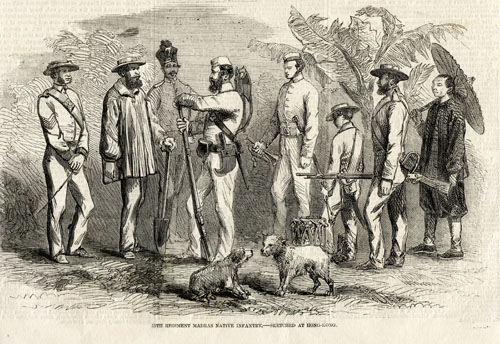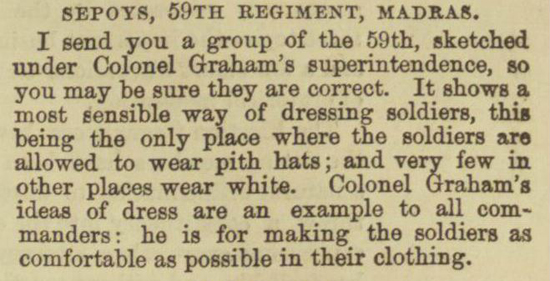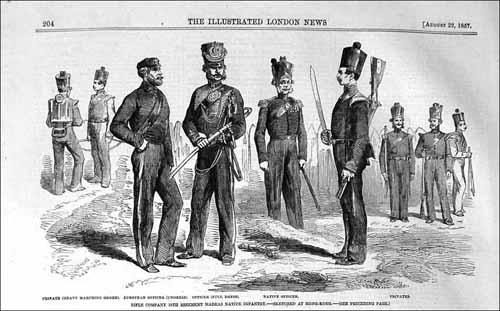The above illustration, from the Illustrated London News, July 1857, piqued my interest because my main area of collecting is British military headdress; however that soon became of lesser importance. The above engraving is captioned “59th Regiment Madras Native Infantry – Sketched at Hong Kong” and its accompanying text states –
Now pith hats or helmets were worn in India from at least the early 1850s but, as already stated, this became of secondary significance when it became apparent that there never was a 59th Regiment Madras Native Infantry.
It soon became obvious that the regiment in question was the 59th (2nd Nottinghamshire) Regiment of Foot who served in Hong Kong from 1849 to 1858. 1 The regiment earned the distinction CANTON (1858) for its services when holding the city of Canton during the second Chinese war of 1857-1858. 2 This then raised the question as to what regiments did the Sepoys, depicted in the engraving, belong, always remembering that the Indian Mutiny was in full swing at this time.
According to C.B. Norman, General Straubenzee, who was then in command of troops in China, had at his disposal the 59th regiment, four battalions of Sepoys, and a couple of battalions of the Royal Marine Light Infantry. 3 Now who were these Indian battalions? Again C.B. Norman 4 lists the following regiments as having the distinction of CHINA (1857-1860) –
- 7th Rajputs (47th Bengal Native Infantry)
- 11th Rajputs (70th Bengal Native Infantry)
- 22nd Punjabis (11th Regiment of Punjab Infantry)
- 27th Punjabis (19th Punjab Infantry)
- 10th Jats (65th Bengal Native Infantry)
- 15th Sikhs (Regiment of Ludhiana)
- 105th Mahratta L.I.
The titles in parentheses are those of the units in 1857 as Norman uses the numbering system introduced by the Kitchener reforms of 1903. This distinction was conferred on regiments which took part in the operations in China during the years 1857-1860.
Of those listed above the 11th Rajputs and the 10th Jats were in Hong Kong at the time of the outbreak of the Mutiny 5 as were the 72nd Punjabis who were titled the 12th Madras Native Infantry in 1857. 6 General Straubenzee also had a detachment of the 38th Madras Native Infantry 7 and there is an Illustrated London News graphic of this unit sketched in Hong Kong and dated 1857. It is interesting that neither the 12th nor the 38th were awarded the CHINA (1857-1860) distinction. This is doubly strange as the 12th Madras Native Infantry are given a casualty return of one man slightly wounded, out of 2 officers and 100 non-commissioned officers and men, at the Storming of Namtow in 1858. 8
The detachment of the 38th with Straubenzee was a Rifle Company and wore a black ball tuft to the top of their shakos and had black facings whereas the Sepoy wearing the frock and shako, in the opening illustration, has neither of these. It is, therefore, probably safe to suggest that it is the 12th Madras Native Infantry in the sketch.
This article is the result of the initial confusion caused by the sketch’s caption which, in the author’s opinion, should have read “59th Regiment and Madras Native Infantry – Sketched at Hong Kong.”
Stuart Bates
Notes
- www.regiments.org
- Norman, C.B., Battle Honours of the British Empire, John Murray, London, 1911
- Ibid.
- Ibid.
- Lovett, A.C., and MacMunn, G.F., The Armies of India, Adam and Charles Black, London, 1911
- http://www.britishempire.co.uk/forces/armyunits/indianinfantry/72ndpunjabis.htm
- Harfield, Alan, The Indian Army of the Empress 1861-1903, Spellmount, Tunbridge Wells, 19908
- The Edinburgh Gazette, October 19, 1858




Thanks Stuart…
How intriguing. One lesson might be, ‘Never trust press captions to military subjects.’
With the mystery of the caption resolved, I am now curious about the broad-brimmed hats worn by four of the European soldiers, I assume of the 95th. Do we assume they are (very) shallow ‘pith’ hats, as described in the accompanying cutting? Without that to guide me I would have thought they were either felt ‘wide-awakes’ or, more likely perhaps, made of straw.
I tend to agree that the hats in the illustration are straw and that the caption is wrong. Perhaps it refers to other headgear worn by the 59th but not shown.
Another mystery to be sure.
Regards,
Stuart
To be fair to the writer of the caption, he does not specifically allude to the headgear of the men in the image as “pith hats.” He simply describes the Hong Kong station as the only place where the men were “allowed to wear pith hats” in 1857, so making possible Colonel Graham’s enlightened attitude to clothing his soldiers in the tropics.
Yes, I have to agree which is essentially what I said in my last reply, although I could have expressed it better.
Stuart
Or I could have read more carefully… I am even more intrigued now to learn that by 1857 soldiers in Hong Kong were wearing already wearing ‘pith hats’ or, in the case of the 95th, snappy broad-brimmed straw hats. I wonder if those latter might have been better suited for wear in barracks than in the field.
Or I could have read more carefully… I am even more intrigued now to learn that by 1857 soldiers in Hong Kong were wearing already wearing ‘pith hats’ or, in the case of the 95th, snappy broad-brimmed straw hats. I wonder if those latter might have been better suited for wear in barracks than in the field.
Do we have any idea as to the form these Hong Kong pith hats might have taken?
In my research I came across a lithograph, alas now lost, which showed the broad brimmed hats being used in combat. A little more research has brought to life the same in the Taking of Sai-Lau, Canton River, 1858 http://en.wikipedia.org/wiki/File:Taking_of_Sai-Lau,_Canton_River,_1858.jpg. The 59th (East Lancashire) Regiment were awarded the Canton 1858 distinction.
Unfortunately I have no further information to add – sadly.
Stuart
Thank you, Stuart.